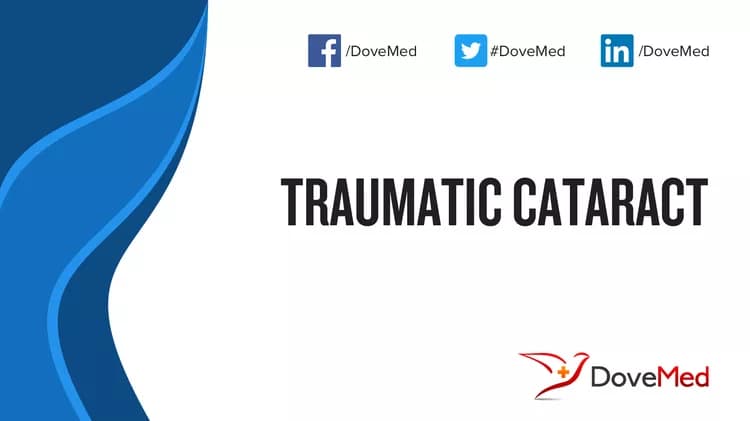What are the other Names for this Condition? (Also known as/Synonyms)
- Injury-Induced Cataract
- Post-Traumatic Cataract
What is Traumatic Cataract? (Definition/Background Information)
- Traumatic Cataract refers to a type of cataract that develops as a result of an eye injury. It occurs when the lens of the eye becomes clouded or opaque due to direct trauma or injury to the eye
- The condition may affect individuals of any age group. The signs and symptoms of a Traumatic Cataract may include blurred or cloudy vision, increased sensitivity to light, and changes in the perception of colors
- A diagnosis of Traumatic Cataract is typically made through a comprehensive eye examination, which may include visual acuity tests and a slit-lamp examination to assess the extent of the cataract
- The treatment of Traumatic Cataracts often involves surgical removal of the cataract and, if necessary, the implantation of an intraocular lens to restore vision
- The prognosis for Traumatic Cataracts can be favorable with prompt and appropriate medical intervention, although the extent of recovery depends on the severity of the injury and associated complications
Who gets Traumatic Cataract? (Age and Sex Distribution)
- Traumatic Cataracts can affect individuals of all ages who have experienced eye injuries
- There is no specific age or gender predilection noted
- The condition is observed across all racial and ethnic groups worldwide
What are the Risk Factors for Traumatic Cataract? (Predisposing Factors)
- Any individual who has experienced an eye injury, such as a blunt trauma, penetrating injury, electrical burns, or chemical or radiation exposure, is at risk for developing Traumatic Cataract
- Certain occupations or activities that carry a higher risk of eye injury, such as construction work or sports, can also be contributory
It is important to note that having a risk factor does not mean that one will get the condition. A risk factor increases one’s chances of getting a condition compared to an individual without the risk factors. Some risk factors are more important than others.
Also, not having a risk factor does not mean that an individual will not get the condition. It is always important to discuss the effect of risk factors with your healthcare provider.
What are the Causes of Traumatic Cataract? (Etiology)
Traumatic cataract is a type of cataract that develops as a result of physical injury or trauma to the eye.
- This may result in damage to the eye lens
- The injury disrupts the arrangement of lens fibers and can lead to the development of opacities, resulting in vision impairment
What are the Signs and Symptoms of Traumatic Cataract?
The signs and symptoms of Traumatic Cataract may include the following:
- Blurred or distorted vision
- Increased glare sensitivity
- Difficulty seeing in low light
- Changes in color perception
The onset of signs and symptoms may vary depending on the severity of the injury.
How is Traumatic Cataract Diagnosed?
An ophthalmologist may perform a comprehensive eye examination to diagnose Traumatic Cataract. The tests performed may include:
- Visual acuity tests
- Slit-lamp biomicroscopy
- Dilated fundus examination to diagnose Traumatic Cataract
- Imaging tests, such as an ultrasound scan, may also be used to assess the extent of the injury
Many clinical conditions may have similar signs and symptoms. Your healthcare provider may perform additional tests to rule out other clinical conditions to arrive at a definitive diagnosis.
What are the possible Complications of Traumatic Cataract?
- Left untreated, Traumatic Cataracts can lead to significant vision loss and impaired daily functioning
- In severe cases, the eye injury may cause additional complications such as retinal detachment or glaucoma
How is Traumatic Cataract Treated?
Surgical intervention is often necessary to treat Traumatic Cataracts.
- Cataract extraction surgery involves removing the cloudy lens and replacing it with an artificial intraocular lens (IOL)
- The timing of surgery may depend on the extent of the injury and the overall eye health
How can Traumatic Cataract be Prevented?
Wearing appropriate protective eyewear during activities that pose a risk of eye injury, such as sports or construction work, can significantly reduce the risk of Traumatic Cataracts. Prompt medical attention after any eye injury is also crucial.
What is the Prognosis of Traumatic Cataract? (Outcomes/Resolutions)
- With timely diagnosis and appropriate surgical treatment, the prognosis for Traumatic Cataracts is generally favorable
- Cataract surgery can lead to improved vision and enhanced quality of life for individuals affected by this condition
Additional and Relevant Useful Information for Traumatic Cataracts:
- A cataract is defined as opacification (to become opaque) or clouding of the natural clear lens that results in visual problems, including blindness
The following resource link may help in better understanding cataracts:
Related Articles
Test Your Knowledge
Asked by users
Related Centers
Related Specialties
Related Physicians
Related Procedures
Related Resources
Join DoveHubs
and connect with fellow professionals


0 Comments
Please log in to post a comment.